Microeconomics and Macroeconomics: Elasticities, Aggregate Demand and GDP
VerifiedAdded on 2023/06/17
|7
|1659
|291
AI Summary
This report discusses the concepts of microeconomics and macroeconomics, including elasticity of demand, aggregate demand, and GDP. It also evaluates the usefulness of elasticities and whether GDP is a good measure of a nation's well-being.
Contribute Materials
Your contribution can guide someone’s learning journey. Share your
documents today.
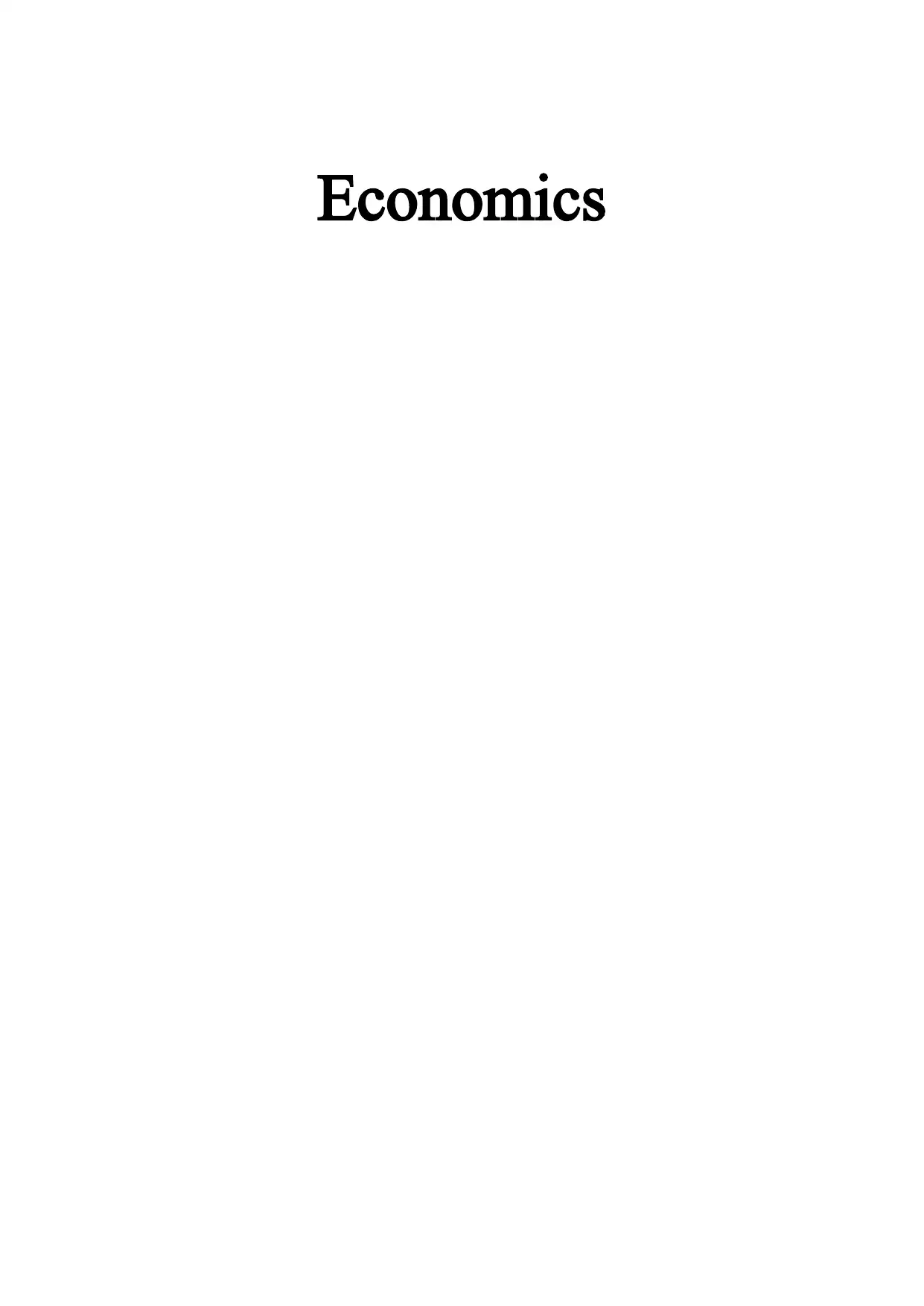
Economics
Secure Best Marks with AI Grader
Need help grading? Try our AI Grader for instant feedback on your assignments.
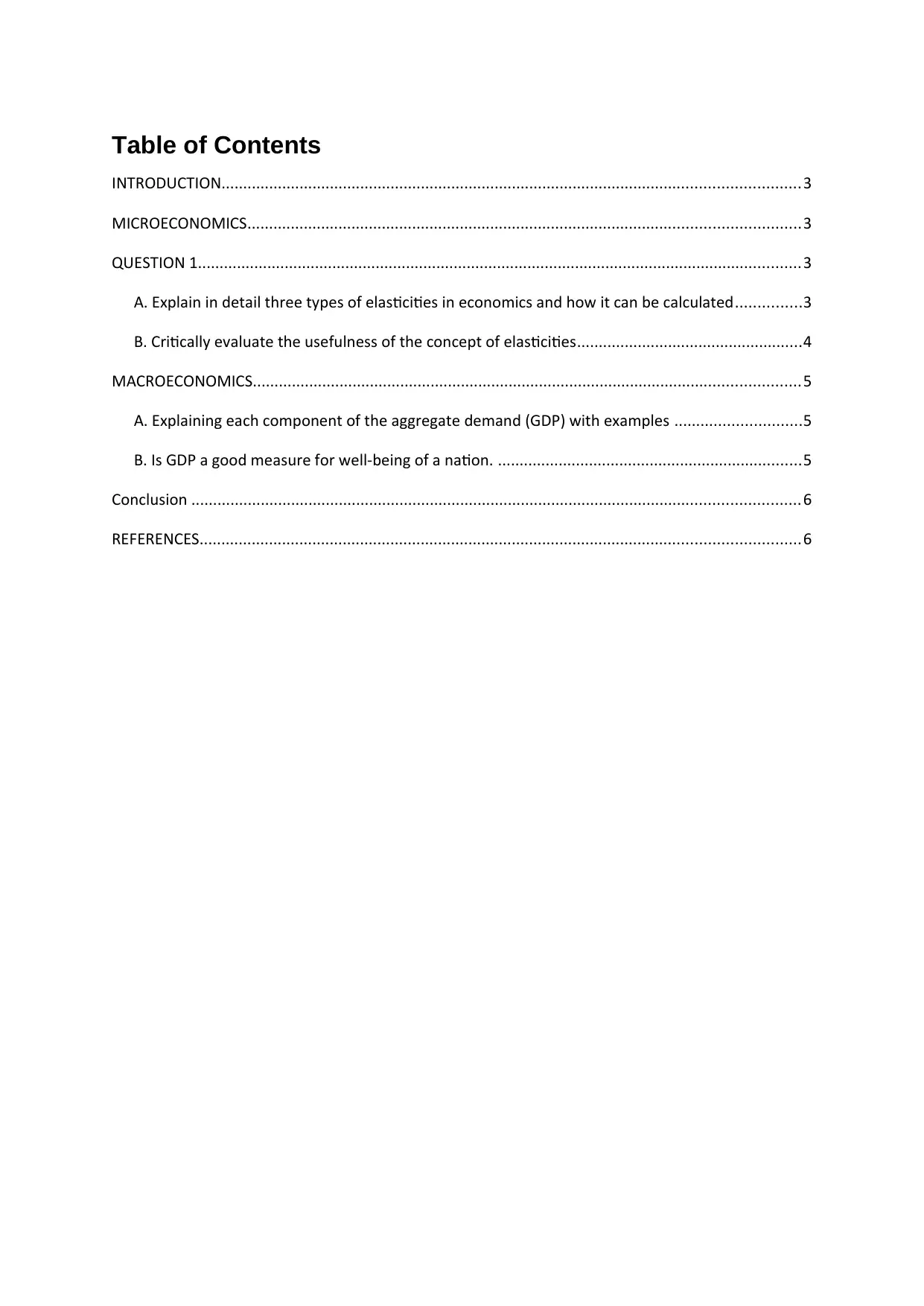
Table of Contents
INTRODUCTION.....................................................................................................................................3
MICROECONOMICS...............................................................................................................................3
QUESTION 1...........................................................................................................................................3
A. Explain in detail three types of elasticities in economics and how it can be calculated...............3
B. Critically evaluate the usefulness of the concept of elasticities....................................................4
MACROECONOMICS..............................................................................................................................5
A. Explaining each component of the aggregate demand (GDP) with examples .............................5
B. Is GDP a good measure for well-being of a nation. ......................................................................5
Conclusion ............................................................................................................................................6
REFERENCES..........................................................................................................................................6
INTRODUCTION.....................................................................................................................................3
MICROECONOMICS...............................................................................................................................3
QUESTION 1...........................................................................................................................................3
A. Explain in detail three types of elasticities in economics and how it can be calculated...............3
B. Critically evaluate the usefulness of the concept of elasticities....................................................4
MACROECONOMICS..............................................................................................................................5
A. Explaining each component of the aggregate demand (GDP) with examples .............................5
B. Is GDP a good measure for well-being of a nation. ......................................................................5
Conclusion ............................................................................................................................................6
REFERENCES..........................................................................................................................................6
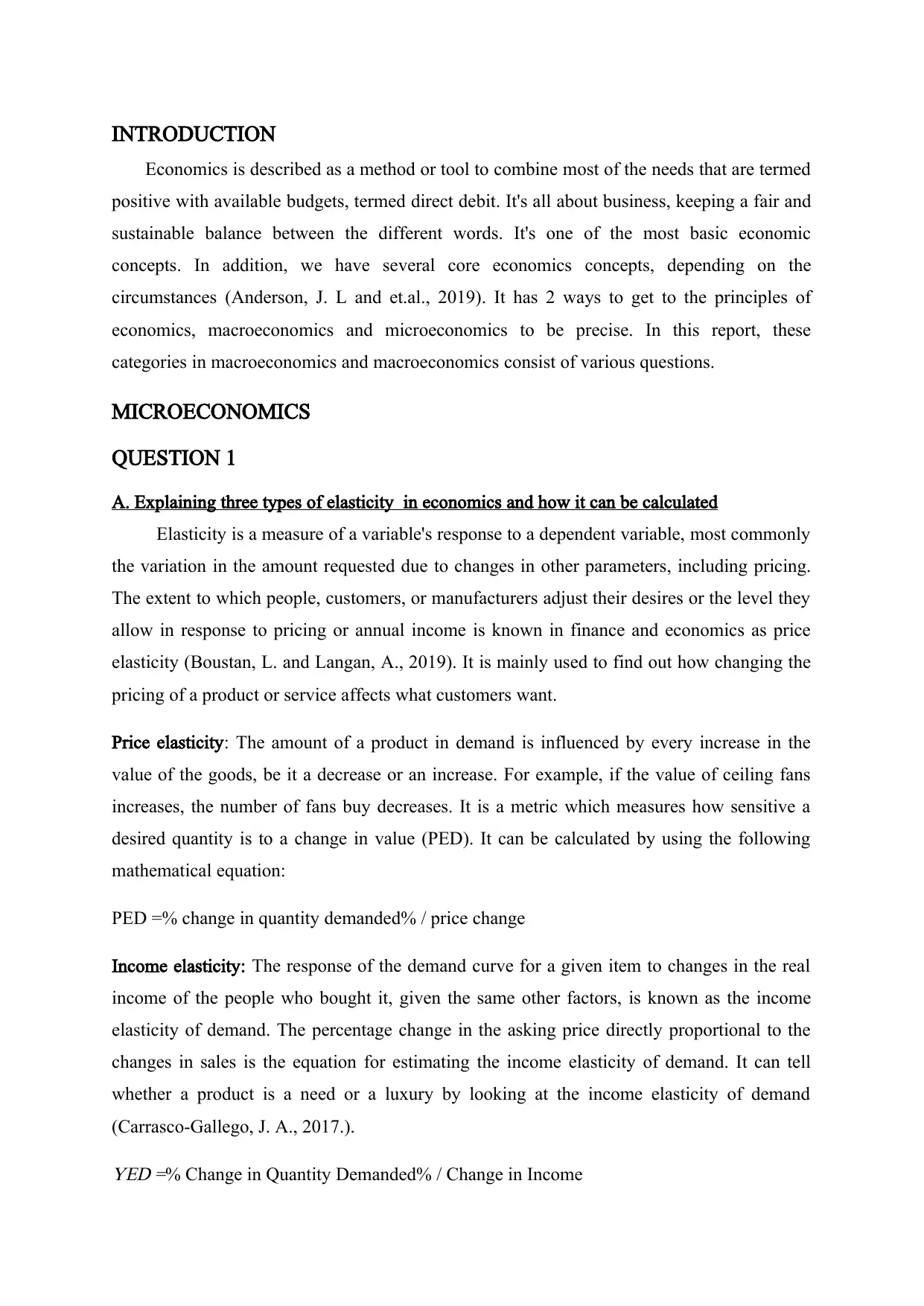
INTRODUCTION
Economics is described as a method or tool to combine most of the needs that are termed
positive with available budgets, termed direct debit. It's all about business, keeping a fair and
sustainable balance between the different words. It's one of the most basic economic
concepts. In addition, we have several core economics concepts, depending on the
circumstances (Anderson, J. L and et.al., 2019). It has 2 ways to get to the principles of
economics, macroeconomics and microeconomics to be precise. In this report, these
categories in macroeconomics and macroeconomics consist of various questions.
MICROECONOMICS
QUESTION 1
A. Explaining three types of elasticity in economics and how it can be calculated
Elasticity is a measure of a variable's response to a dependent variable, most commonly
the variation in the amount requested due to changes in other parameters, including pricing.
The extent to which people, customers, or manufacturers adjust their desires or the level they
allow in response to pricing or annual income is known in finance and economics as price
elasticity (Boustan, L. and Langan, A., 2019). It is mainly used to find out how changing the
pricing of a product or service affects what customers want.
Price elasticity: The amount of a product in demand is influenced by every increase in the
value of the goods, be it a decrease or an increase. For example, if the value of ceiling fans
increases, the number of fans buy decreases. It is a metric which measures how sensitive a
desired quantity is to a change in value (PED). It can be calculated by using the following
mathematical equation:
PED =% change in quantity demanded% / price change
Income elasticity: The response of the demand curve for a given item to changes in the real
income of the people who bought it, given the same other factors, is known as the income
elasticity of demand. The percentage change in the asking price directly proportional to the
changes in sales is the equation for estimating the income elasticity of demand. It can tell
whether a product is a need or a luxury by looking at the income elasticity of demand
(Carrasco-Gallego, J. A., 2017.).
YED =% Change in Quantity Demanded% / Change in Income
Economics is described as a method or tool to combine most of the needs that are termed
positive with available budgets, termed direct debit. It's all about business, keeping a fair and
sustainable balance between the different words. It's one of the most basic economic
concepts. In addition, we have several core economics concepts, depending on the
circumstances (Anderson, J. L and et.al., 2019). It has 2 ways to get to the principles of
economics, macroeconomics and microeconomics to be precise. In this report, these
categories in macroeconomics and macroeconomics consist of various questions.
MICROECONOMICS
QUESTION 1
A. Explaining three types of elasticity in economics and how it can be calculated
Elasticity is a measure of a variable's response to a dependent variable, most commonly
the variation in the amount requested due to changes in other parameters, including pricing.
The extent to which people, customers, or manufacturers adjust their desires or the level they
allow in response to pricing or annual income is known in finance and economics as price
elasticity (Boustan, L. and Langan, A., 2019). It is mainly used to find out how changing the
pricing of a product or service affects what customers want.
Price elasticity: The amount of a product in demand is influenced by every increase in the
value of the goods, be it a decrease or an increase. For example, if the value of ceiling fans
increases, the number of fans buy decreases. It is a metric which measures how sensitive a
desired quantity is to a change in value (PED). It can be calculated by using the following
mathematical equation:
PED =% change in quantity demanded% / price change
Income elasticity: The response of the demand curve for a given item to changes in the real
income of the people who bought it, given the same other factors, is known as the income
elasticity of demand. The percentage change in the asking price directly proportional to the
changes in sales is the equation for estimating the income elasticity of demand. It can tell
whether a product is a need or a luxury by looking at the income elasticity of demand
(Carrasco-Gallego, J. A., 2017.).
YED =% Change in Quantity Demanded% / Change in Income
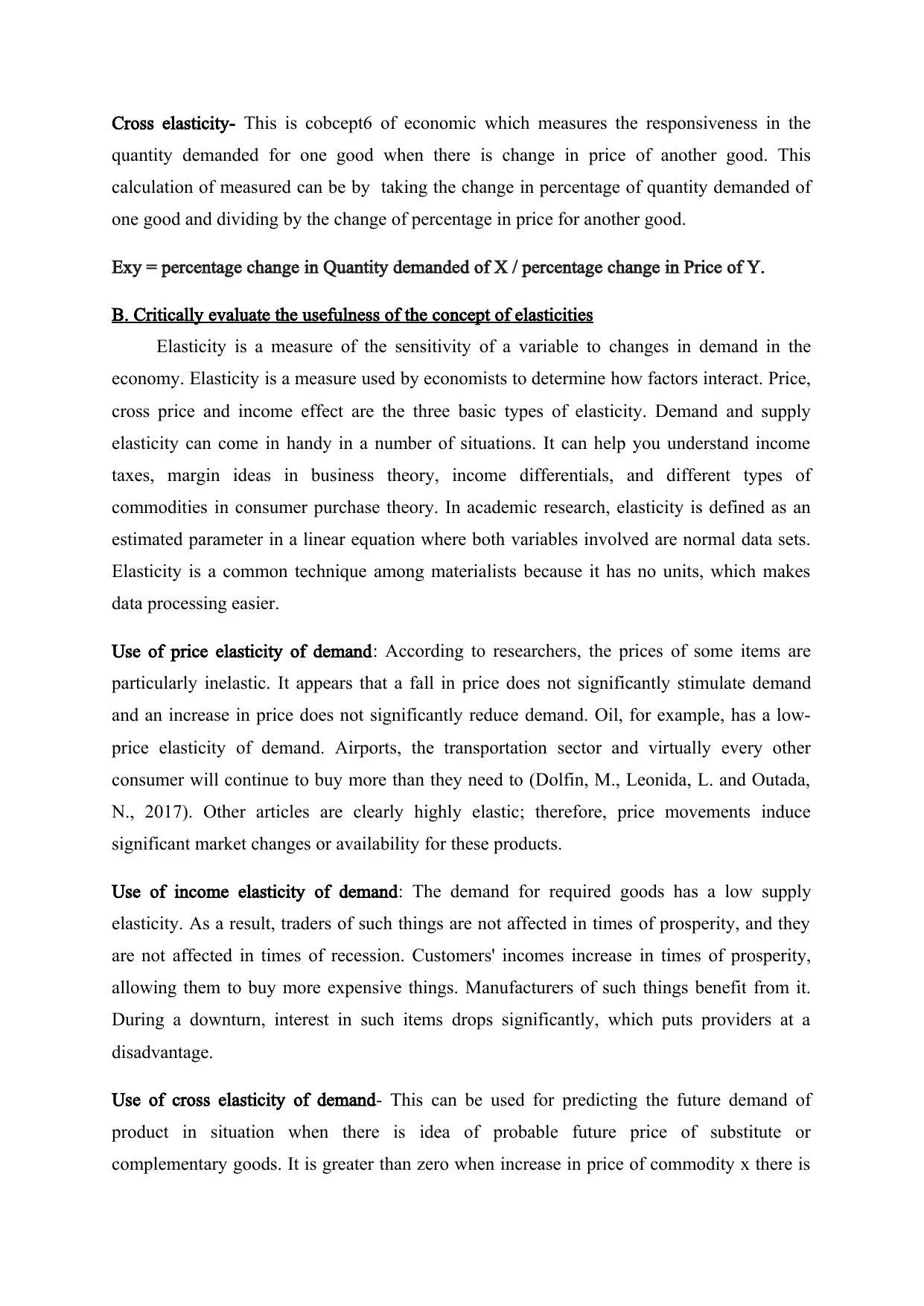
Cross elasticity- This is cobcept6 of economic which measures the responsiveness in the
quantity demanded for one good when there is change in price of another good. This
calculation of measured can be by taking the change in percentage of quantity demanded of
one good and dividing by the change of percentage in price for another good.
Exy = percentage change in Quantity demanded of X / percentage change in Price of Y.
B. Critically evaluate the usefulness of the concept of elasticities
Elasticity is a measure of the sensitivity of a variable to changes in demand in the
economy. Elasticity is a measure used by economists to determine how factors interact. Price,
cross price and income effect are the three basic types of elasticity. Demand and supply
elasticity can come in handy in a number of situations. It can help you understand income
taxes, margin ideas in business theory, income differentials, and different types of
commodities in consumer purchase theory. In academic research, elasticity is defined as an
estimated parameter in a linear equation where both variables involved are normal data sets.
Elasticity is a common technique among materialists because it has no units, which makes
data processing easier.
Use of price elasticity of demand: According to researchers, the prices of some items are
particularly inelastic. It appears that a fall in price does not significantly stimulate demand
and an increase in price does not significantly reduce demand. Oil, for example, has a low-
price elasticity of demand. Airports, the transportation sector and virtually every other
consumer will continue to buy more than they need to (Dolfin, M., Leonida, L. and Outada,
N., 2017). Other articles are clearly highly elastic; therefore, price movements induce
significant market changes or availability for these products.
Use of income elasticity of demand: The demand for required goods has a low supply
elasticity. As a result, traders of such things are not affected in times of prosperity, and they
are not affected in times of recession. Customers' incomes increase in times of prosperity,
allowing them to buy more expensive things. Manufacturers of such things benefit from it.
During a downturn, interest in such items drops significantly, which puts providers at a
disadvantage.
Use of cross elasticity of demand- This can be used for predicting the future demand of
product in situation when there is idea of probable future price of substitute or
complementary goods. It is greater than zero when increase in price of commodity x there is
quantity demanded for one good when there is change in price of another good. This
calculation of measured can be by taking the change in percentage of quantity demanded of
one good and dividing by the change of percentage in price for another good.
Exy = percentage change in Quantity demanded of X / percentage change in Price of Y.
B. Critically evaluate the usefulness of the concept of elasticities
Elasticity is a measure of the sensitivity of a variable to changes in demand in the
economy. Elasticity is a measure used by economists to determine how factors interact. Price,
cross price and income effect are the three basic types of elasticity. Demand and supply
elasticity can come in handy in a number of situations. It can help you understand income
taxes, margin ideas in business theory, income differentials, and different types of
commodities in consumer purchase theory. In academic research, elasticity is defined as an
estimated parameter in a linear equation where both variables involved are normal data sets.
Elasticity is a common technique among materialists because it has no units, which makes
data processing easier.
Use of price elasticity of demand: According to researchers, the prices of some items are
particularly inelastic. It appears that a fall in price does not significantly stimulate demand
and an increase in price does not significantly reduce demand. Oil, for example, has a low-
price elasticity of demand. Airports, the transportation sector and virtually every other
consumer will continue to buy more than they need to (Dolfin, M., Leonida, L. and Outada,
N., 2017). Other articles are clearly highly elastic; therefore, price movements induce
significant market changes or availability for these products.
Use of income elasticity of demand: The demand for required goods has a low supply
elasticity. As a result, traders of such things are not affected in times of prosperity, and they
are not affected in times of recession. Customers' incomes increase in times of prosperity,
allowing them to buy more expensive things. Manufacturers of such things benefit from it.
During a downturn, interest in such items drops significantly, which puts providers at a
disadvantage.
Use of cross elasticity of demand- This can be used for predicting the future demand of
product in situation when there is idea of probable future price of substitute or
complementary goods. It is greater than zero when increase in price of commodity x there is
Secure Best Marks with AI Grader
Need help grading? Try our AI Grader for instant feedback on your assignments.
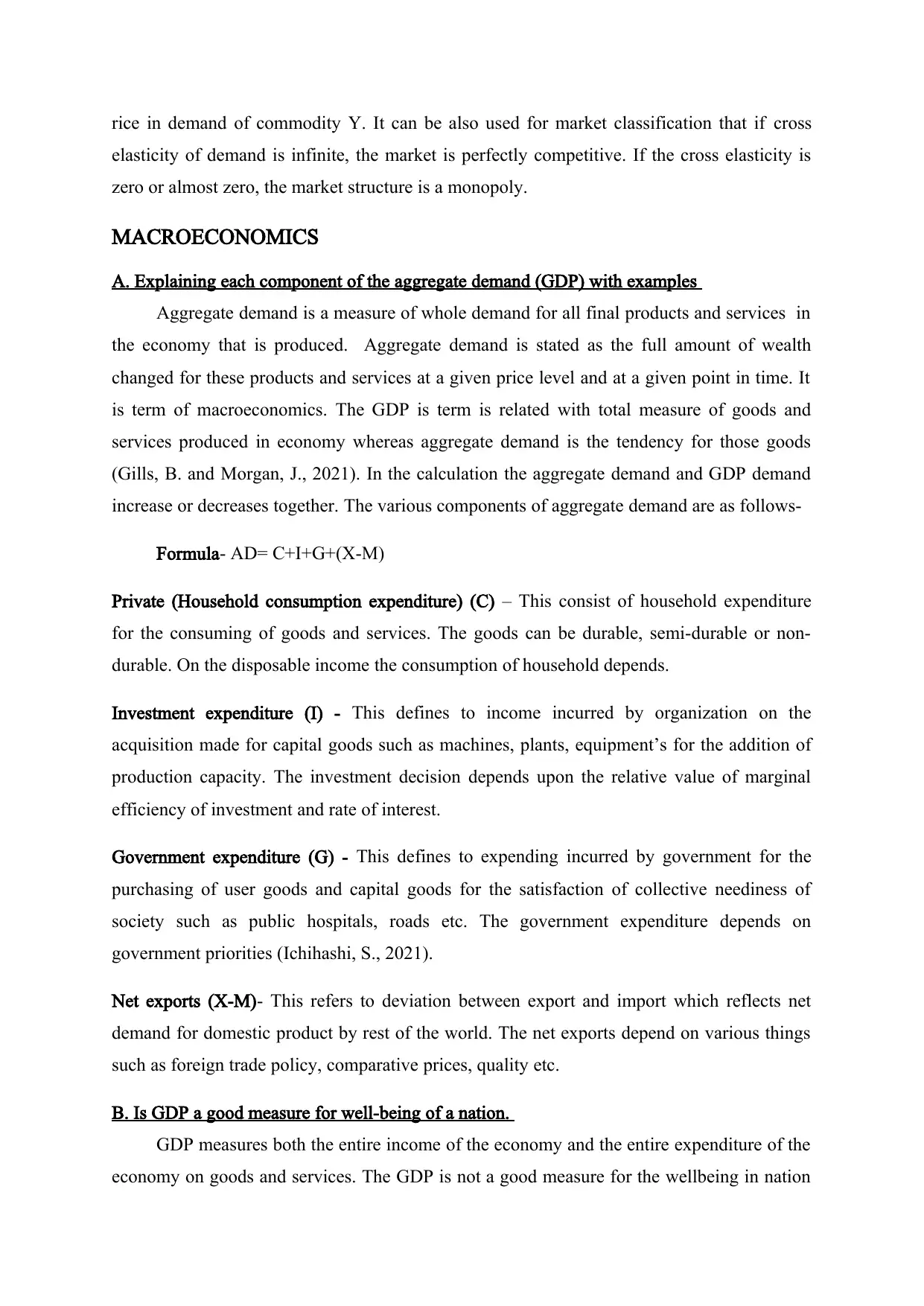
rice in demand of commodity Y. It can be also used for market classification that if cross
elasticity of demand is infinite, the market is perfectly competitive. If the cross elasticity is
zero or almost zero, the market structure is a monopoly.
MACROECONOMICS
A. Explaining each component of the aggregate demand (GDP) with examples
Aggregate demand is a measure of whole demand for all final products and services in
the economy that is produced. Aggregate demand is stated as the full amount of wealth
changed for these products and services at a given price level and at a given point in time. It
is term of macroeconomics. The GDP is term is related with total measure of goods and
services produced in economy whereas aggregate demand is the tendency for those goods
(Gills, B. and Morgan, J., 2021). In the calculation the aggregate demand and GDP demand
increase or decreases together. The various components of aggregate demand are as follows-
Formula- AD= C+I+G+(X-M)
Private (Household consumption expenditure) (C) – This consist of household expenditure
for the consuming of goods and services. The goods can be durable, semi-durable or non-
durable. On the disposable income the consumption of household depends.
Investment expenditure (I) - This defines to income incurred by organization on the
acquisition made for capital goods such as machines, plants, equipment’s for the addition of
production capacity. The investment decision depends upon the relative value of marginal
efficiency of investment and rate of interest.
Government expenditure (G) - This defines to expending incurred by government for the
purchasing of user goods and capital goods for the satisfaction of collective neediness of
society such as public hospitals, roads etc. The government expenditure depends on
government priorities (Ichihashi, S., 2021).
Net exports (X-M)- This refers to deviation between export and import which reflects net
demand for domestic product by rest of the world. The net exports depend on various things
such as foreign trade policy, comparative prices, quality etc.
B. Is GDP a good measure for well-being of a nation.
GDP measures both the entire income of the economy and the entire expenditure of the
economy on goods and services. The GDP is not a good measure for the wellbeing in nation
elasticity of demand is infinite, the market is perfectly competitive. If the cross elasticity is
zero or almost zero, the market structure is a monopoly.
MACROECONOMICS
A. Explaining each component of the aggregate demand (GDP) with examples
Aggregate demand is a measure of whole demand for all final products and services in
the economy that is produced. Aggregate demand is stated as the full amount of wealth
changed for these products and services at a given price level and at a given point in time. It
is term of macroeconomics. The GDP is term is related with total measure of goods and
services produced in economy whereas aggregate demand is the tendency for those goods
(Gills, B. and Morgan, J., 2021). In the calculation the aggregate demand and GDP demand
increase or decreases together. The various components of aggregate demand are as follows-
Formula- AD= C+I+G+(X-M)
Private (Household consumption expenditure) (C) – This consist of household expenditure
for the consuming of goods and services. The goods can be durable, semi-durable or non-
durable. On the disposable income the consumption of household depends.
Investment expenditure (I) - This defines to income incurred by organization on the
acquisition made for capital goods such as machines, plants, equipment’s for the addition of
production capacity. The investment decision depends upon the relative value of marginal
efficiency of investment and rate of interest.
Government expenditure (G) - This defines to expending incurred by government for the
purchasing of user goods and capital goods for the satisfaction of collective neediness of
society such as public hospitals, roads etc. The government expenditure depends on
government priorities (Ichihashi, S., 2021).
Net exports (X-M)- This refers to deviation between export and import which reflects net
demand for domestic product by rest of the world. The net exports depend on various things
such as foreign trade policy, comparative prices, quality etc.
B. Is GDP a good measure for well-being of a nation.
GDP measures both the entire income of the economy and the entire expenditure of the
economy on goods and services. The GDP is not a good measure for the wellbeing in nation

as it uses market pricing for valuing goods and services and excludes all the activity that
takes place outside markets.
Conclusion
From the above report it was concluded that analyzing how the community distributes
limited resources for the business is called economics which comprises of micro and
macroeconomics. In the report elasticity of demand with its types is discussed. In
microeconomics its use of elasticity is also considered. In the part of Macroeconomics
aggregate demand is explained with its components and is GDP is good measure for well-
being.
REFERENCES
Books and Journal
Anderson, J. L., Asche, F. and Garlock, T., 2019. Economics of aquaculture policy and
regulation.
Annual Review of Resource Economics. 11. pp.101-123.
Boustan, L. and Langan, A., 2019. Variation in Women's Success across PhD Programs in
Economics.
Journal of Economic Perspectives. 33(1). pp.23-42.
Carrasco-Gallego, J. A., 2017. Introducing economics to millennials.
International review of
Economics education. 26. pp.19-29.
Dolfin, M., Leonida, L. and Outada, N., 2017. Modeling human behavior in economics and
social science.
Physics of life reviews. 22. pp.1-21.
Gills, B. and Morgan, J., 2021. Economics and climate emergency.
Globalizations. 18(7).
pp.1071-1086.
Ichihashi, S., 2021. The economics of data externalities.
Journal of Economic Theory. 196.
p.105316
takes place outside markets.
Conclusion
From the above report it was concluded that analyzing how the community distributes
limited resources for the business is called economics which comprises of micro and
macroeconomics. In the report elasticity of demand with its types is discussed. In
microeconomics its use of elasticity is also considered. In the part of Macroeconomics
aggregate demand is explained with its components and is GDP is good measure for well-
being.
REFERENCES
Books and Journal
Anderson, J. L., Asche, F. and Garlock, T., 2019. Economics of aquaculture policy and
regulation.
Annual Review of Resource Economics. 11. pp.101-123.
Boustan, L. and Langan, A., 2019. Variation in Women's Success across PhD Programs in
Economics.
Journal of Economic Perspectives. 33(1). pp.23-42.
Carrasco-Gallego, J. A., 2017. Introducing economics to millennials.
International review of
Economics education. 26. pp.19-29.
Dolfin, M., Leonida, L. and Outada, N., 2017. Modeling human behavior in economics and
social science.
Physics of life reviews. 22. pp.1-21.
Gills, B. and Morgan, J., 2021. Economics and climate emergency.
Globalizations. 18(7).
pp.1071-1086.
Ichihashi, S., 2021. The economics of data externalities.
Journal of Economic Theory. 196.
p.105316

1 out of 7
Related Documents
Your All-in-One AI-Powered Toolkit for Academic Success.
+13062052269
info@desklib.com
Available 24*7 on WhatsApp / Email
![[object Object]](/_next/static/media/star-bottom.7253800d.svg)
Unlock your academic potential
© 2024 | Zucol Services PVT LTD | All rights reserved.




